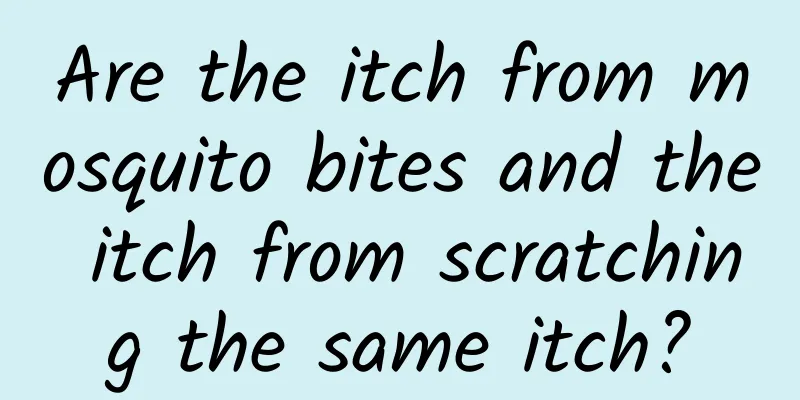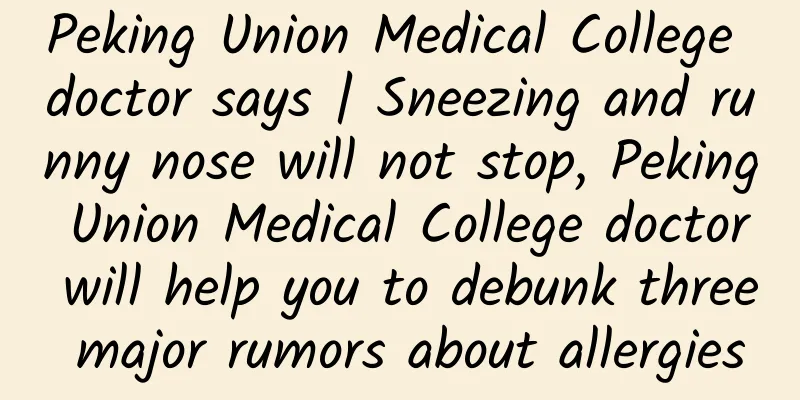Are the itch from mosquito bites and the itch from scratching the same itch?

|
When the weather gets hot, what is unbearable is not only the rising temperature, but also the mosquitoes that leave you nowhere to escape. What makes us realize that we have been bitten by mosquitoes is often not the "murderer" itself, but the unpleasant itchy feeling. For the itchy feeling of mosquito bites, the moment you scratch it, you feel extremely refreshed, but the moment you stop, you feel itchy. So the question is, compared to the itch caused by being tickled, which makes you feel very itchy while scratching but feels extremely refreshing the moment you stop, are the itch caused by mosquito bites and the itch caused by being tickled the same kind of itch? Understanding Itch Vision, hearing, smell, taste, cold, heat, pain, itch, etc. are all sensations, which are the product of the brain processing the external stimuli transmitted by the nervous system to the sensory cells. Itch is an unpleasant feeling that causes the body to want to scratch, which was first defined by German physician Samuel Hafenreffer in 1660. Samuel Hafenreffer's unhappy face Just like pain is to keep animals away from harm, itch is also a self-protection mechanism of animals. For some harmless contacts, such as contact between clothes and skin, the body chooses to ignore them. For contacts that cause physical discomfort, the body's response is to remove them, such as mosquito bites. This difference from harmless contact is itch, and the body's response is to scratch. Itch signaling pathways The itch sensation needs to be transmitted through several "relays" of nerve cells before it can be transmitted to the body sensory center of the brain. The currently recognized itch transmission pathway is roughly: nerve endings (stimulated) - spinal cord dorsal horn - spinothalamic tract - cerebral cortex (produces itch sensation). The transmission of itch sensation from the spinal cord to the brain has always been a difficult problem in the itch signal transmission pathway. It was not until 2017 that Sun Yangang and his team from the Institute of Neuroscience of the Chinese Academy of Sciences revealed for the first time an important pathway for the transmission of itch from the spinal cord to the brain, namely, the spinal cord-parabrachial nucleus projection is involved in the transmission of itch information, and the parabrachial nucleus is an important brain area involved in the processing of itch information. Previous studies have found that when itchy stimulation occurs, neurons projecting from the dorsal spinal cord to the parabrachial nucleus of the brain are activated. The researchers hypothesized that the parabrachial nucleus may be involved in the sensation of itch. Next, the experiment proved this hypothesis. The projection from the spinal cord to the parabrachial nucleus was blocked by optogenetics, and it was found that the scratching response of mice to itch stimulation was significantly reduced. Mu et al. 2017 (image modified) Itch and pain, friends or foes? Many people have had this experience: after being bitten by a mosquito, they will scratch the bite unconsciously, and even scratch it. When they feel the burning pain, the itching feeling disappears. After the pain disappears, the itching feeling reappears. The understanding of pain and itching is also a bumpy experience. Initially, it was believed that itch and pain were encoded by the same neurons. Smaller stimulation intensity encoded itch, while larger stimulation intensity encoded pain. However, more and more evidence has now refuted this view. The mainstream theories at present are the selectivity theory and the specificity theory. The selectivity theory believes that the generation and transmission of itch is specifically undertaken by a part of neurons in the body, and is independent of the transmission of other sensations such as pain; while the specificity theory believes that although there are some unique sensory projection neurons in the itch pathway, the overall transmission of itch and other sensations such as pain are interconnected, and that pain transmission will inhibit the transmission of itch signals. This is why scratching lightly when it itches can temporarily relieve the itch. Selectivity theory and specificity theory of itch transmission There are many receptors that sense itch. There are many factors that can cause itching, such as mosquito bites, light touch, contact with certain plants, wound healing, infection, etc. For various itching factors, the body will also have many kinds of receptors to sense these stimuli, thus producing an itchy feeling. The itchy chemical substance caused by mosquito bites, urticaria, etc. is histamine, which is formed by the removal of the carboxyl group of histidine. When the skin is stimulated, histamine is secreted and binds to the histamine receptors in the skin to form an itch signal. The seeds of Mucuna pricklyris can also make people feel extremely itchy. The thorns on its pods contain mucuna protease, which can bind to a protease-activated receptor in the skin to produce an itch signal. The itch receptors that have been studied so far mainly include seven categories, namely histamine receptors, interleukin receptors, protease-activated receptors, opioid receptors, cannabinoid receptors, gastrin-releasing peptide receptors and transient voltage receptors. Mechanical itch and chemical itch have different conduction pathways Based on the differences in transmission pathways, researchers divide itch into mechanical itch and chemical itch. For harmless touch, the body will choose to ignore and not react; but for some light touch, such as ants crawling across the arm, plants brushing across the exposed skin, etc., the body will feel itchy. How does the body distinguish between the two? The study found that neuropeptide Y expressed by spinal dorsal horn neurons plays a key role in this process, which can pass through some itch sensations caused by slight touches, while ignoring others. American scientist Martyn Gouding found that if these neurons in the spinal cord of mice were removed, the mice would perceive all slight touches as itch signals and scratch continuously. Differences in the transduction pathways of chemical and mechanical itch In the chemical itch transmission pathway, the gastrin releasing peptide receptor expressed by the spinal dorsal horn neurons plays an important role. Studies have shown that the loss of gastrin releasing peptide receptors can significantly reduce the scratching response induced by chemical peptides. Removing neuropeptide Y neurons and gastrin releasing peptide secreting neurons at the same time cannot eliminate the itch caused by mechanical stimulation. This shows that the transmission pathways of chemical itch and mechanical itch are different. Mechanical itch can be induced by non-harmful touch, electrical stimulation, etc., while chemical itch can be stimulated by chemical substances such as histamine and chloroquine. The two produce corresponding signals through different sensory neurons. For example, scratching is mainly a mechanical itch caused by light touch, while mosquito bites are chemical itch caused by histamine. Chemical itch, itch conduction pathways also have high and low The itch signaling pathways of chemical itch can also be divided into two types, namely histamine-dependent itch signaling pathway and histamine-independent itch signaling pathway. The difference between the two is that the nerve fibers that transmit itch signals are different. The histamine-dependent itch signaling pathway is similar to an ordinary road, slow but widely distributed. It is mediated by unmyelinated C fibers (CMi) that are insensitive to mechanical stimulation. The fiber conduction speed is slow, the nerve innervation is extensive, and it can be activated by histamine. Its nerve endings are mainly distributed at the boundary between the dermis and the epidermis. A few are directly distributed in the epidermis. After the nerve endings are stimulated by histamine, they transmit the signal to the dorsal horn of the spinal cord. The signal is then transmitted to the thalamus along the spinothalamic tract and continues to ascend to the sensory center of the brain. The non-histamine-dependent itch signaling pathway is similar to a highway, with a faster transmission speed. It is mediated by mechano-thermosensitive C fibers (CMHs), whose nerve endings are mainly distributed in the epidermis. CMHs transmit itch signals to the dorsal horn of the spinal cord, and then ascend along the spinothalamic tract to the thalamus, and continue to ascend to the sensory center of the brain. Different itch stimuli can activate different brain areas So far, no research has been able to clearly indicate that a certain brain region is the center of itch perception or regulation. Brain imaging studies have found that there are differences in the brain regions activated by histamine and mucunain. This suggests that different itch-inducing stimuli also activate different brain regions. The green area is the brain area activated by histamine, the blue area is the brain area activated by mucunain, and the red area is the brain area activated by both. Alexandru DP Papoiu et al, 2012 So, although they are called the same thing, the itch from a mosquito bite and the itch from a tickle are not actually exactly the same feeling. References: http://www.wikiwand.com/en/Samuel_Hafenreffer Bourane, Steeve, et al. "Gate control of mechanical itch by a subpopulation of spinal cord interneurons." Science 350.6260 (2015): 550-554. Papoiu, Alexandru DP, et al. "A tale of two itches. Common features and notable differences in brain activation evoked by cowhage and histamine induced itch." Neuroimage 59.4 (2012): 3611-3623. Green, Dustin, and Xinzhong Dong. "The cell biology of acute itch." J Cell Biol 213.2 (2016): 155-161. Sun YG, Chen ZF. A gastrin-releasing peptide receptor mediates the itch sensation in the spinal cord. Nature July 25, 2007, advance online publication. Alexandru DP et al. Tale of Two Itches. Common Features and Notable Differences in Brain Activation Evoked by Cowhage And Histamine Induced Itch. Neuroimage. 2012 Feb 15; 59(4): 3611–3623. Mu D, Deng J, Liu KF, et al. A central neural circuit for itch sensation[J]. Science, 2017, 357(6352): 695-699. Author: Duke Cat (Institute of Hydrobiology, Chinese Academy of Sciences) The article comes from the Science Academy official account |
<<: Is an electric clothes drying rack better or a manual one? How to choose a clothes drying rack
>>: How to prevent breast cancer if you don’t understand breasts?
Recommend
What is the normal size of the uterus?
The uterus is a very important reproductive organ...
Racket-shaped placenta pictures
The normal embryo is round or oval in shape, and ...
This disease is actually gender-specific? Come and see what's going on!
There is a disease in which the male-to-female ra...
Symptoms of infertility and timely treatment of infertility
Nowadays, more and more women have symptoms of in...
Back pain areas diagram
The day before yesterday, a female friend joked t...
Will women's private parts turn black if they do it too much?
Many women are troubled by the darkening of their...
Why is the Wuhan pneumonia spreading so quickly? Is the probability of human-to-human transmission of the new pneumonia in Wuhan high?
Friends in Wuhan have been paying attention to th...
How effective is acupuncture in treating premature ovarian failure?
Many women find that there is something wrong wit...
Back pain at 10 weeks pregnant
Pregnancy is a very difficult process, because du...
What are the benefits of vaginal tightening?
Many women now choose to undergo vaginal tighteni...
How to tighten it if it's loose down there
"How can I make it tighter when it's loo...
What is the cause of menstrual irregularity?
Nowadays, many women always have problems with ir...
Numbness in women's hands and feet_What disease is it
I believe many people have experienced the phenom...
The latest news on Wuhan's lifting of the lockdown in 2020 What are the prerequisites for Wuhan's lifting of the lockdown?
Has Wuhan been unsealed? When will it be unsealed...
What vitamin deficiency causes dry skin? Check it out now
In life, many women pay special attention to hydr...









